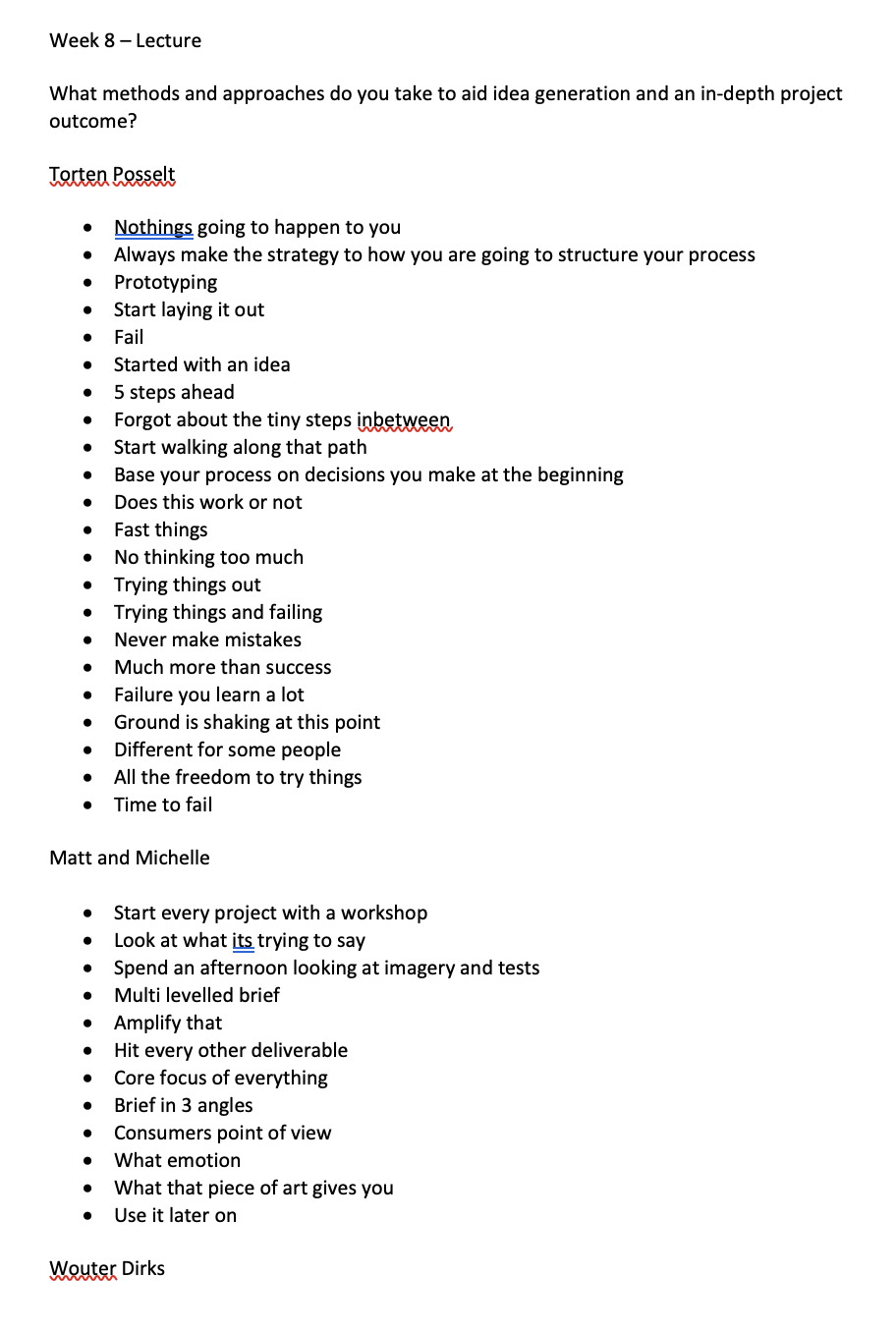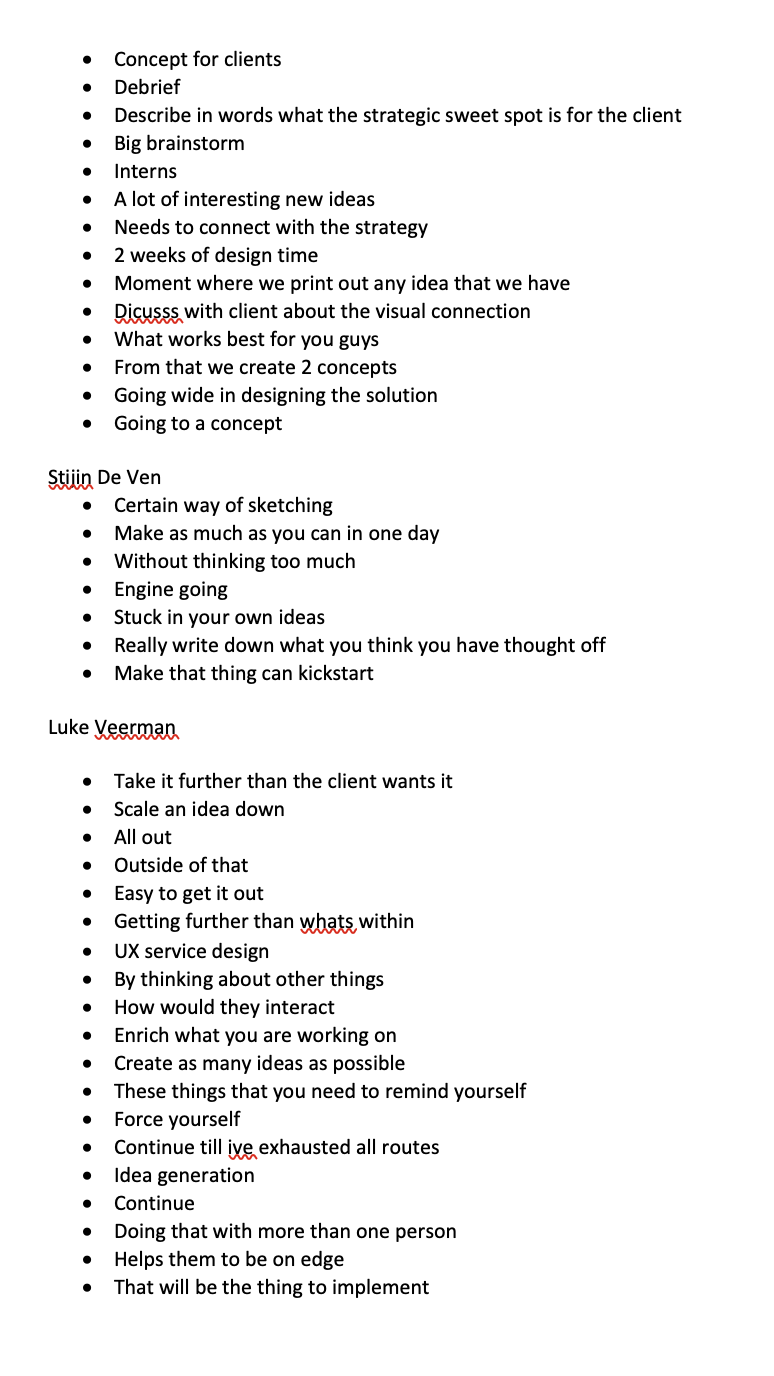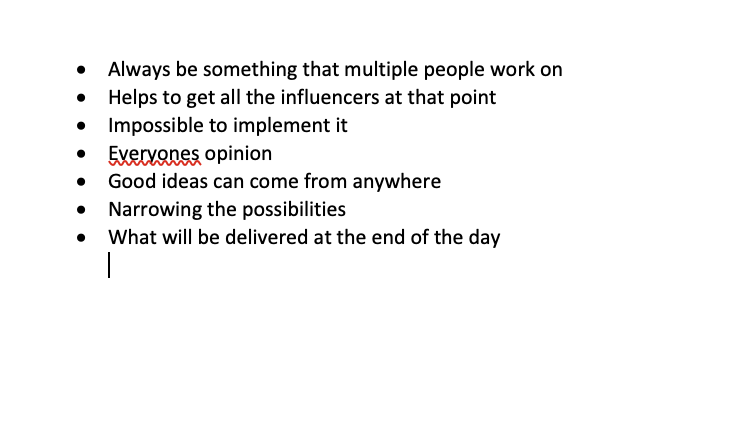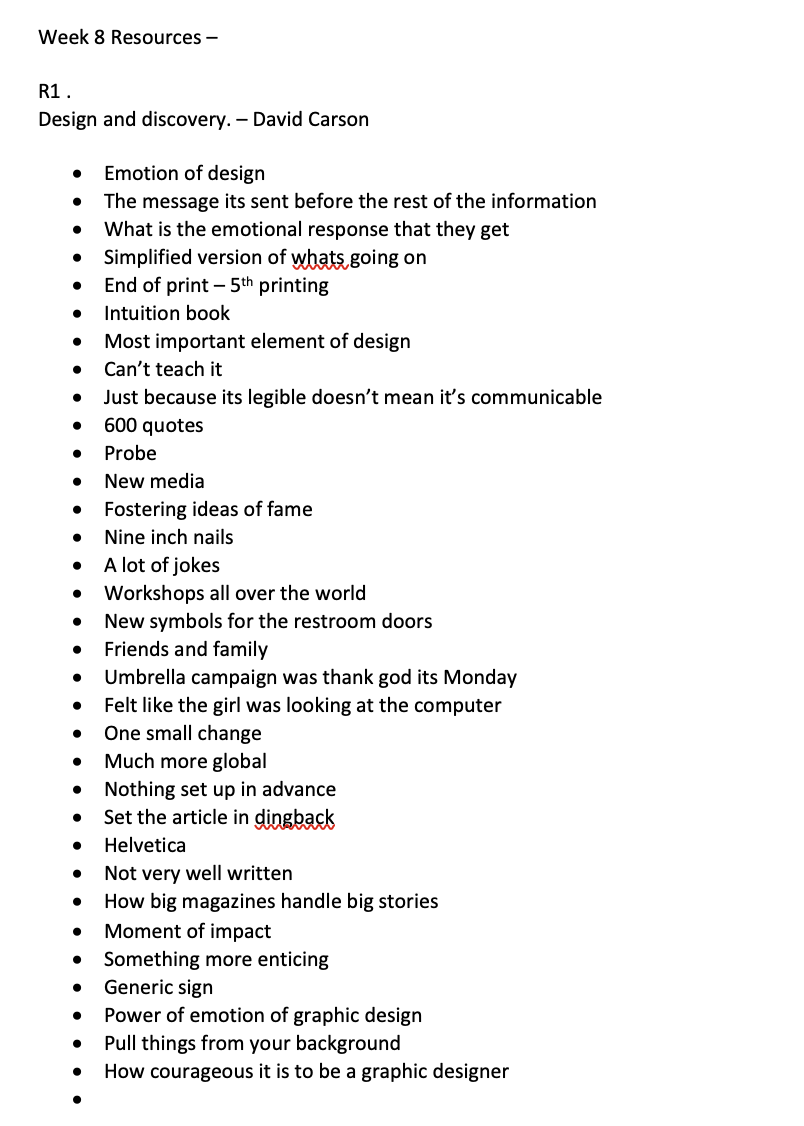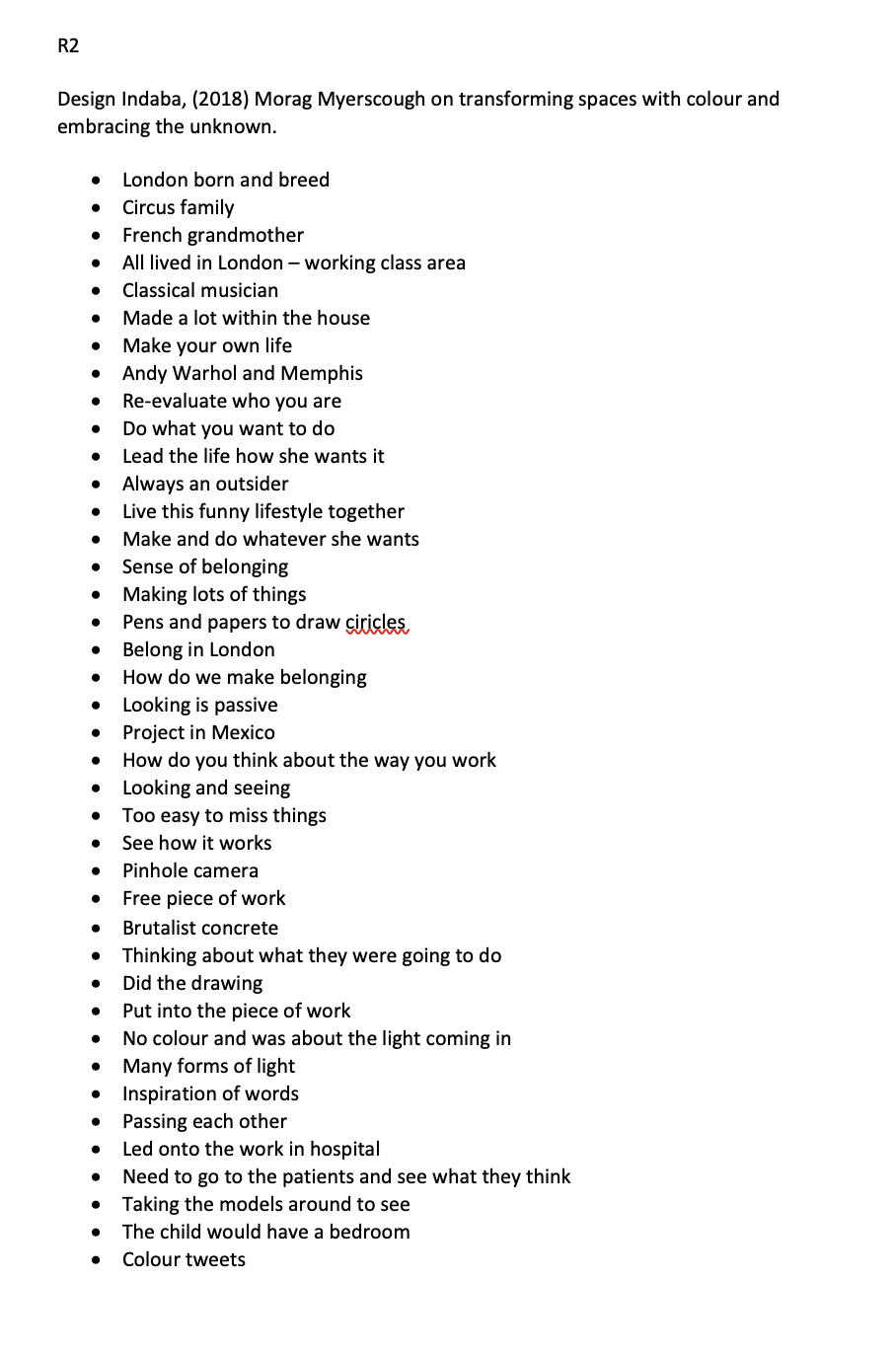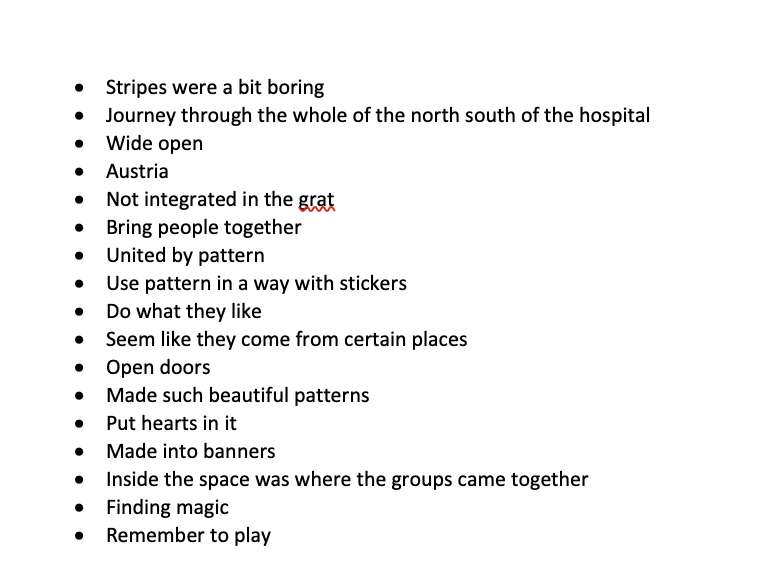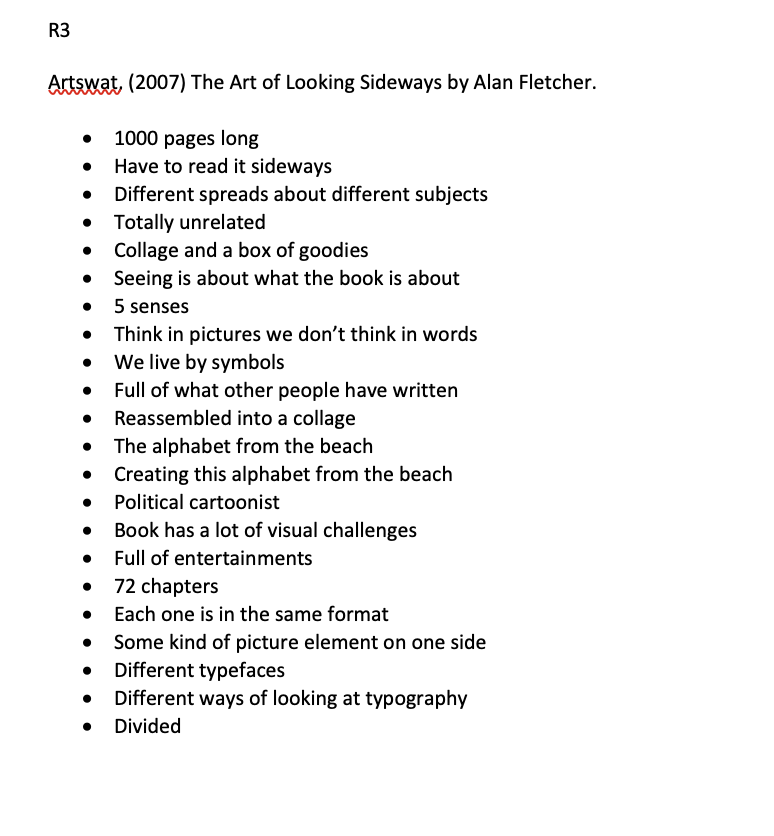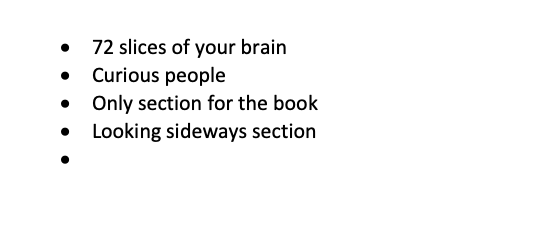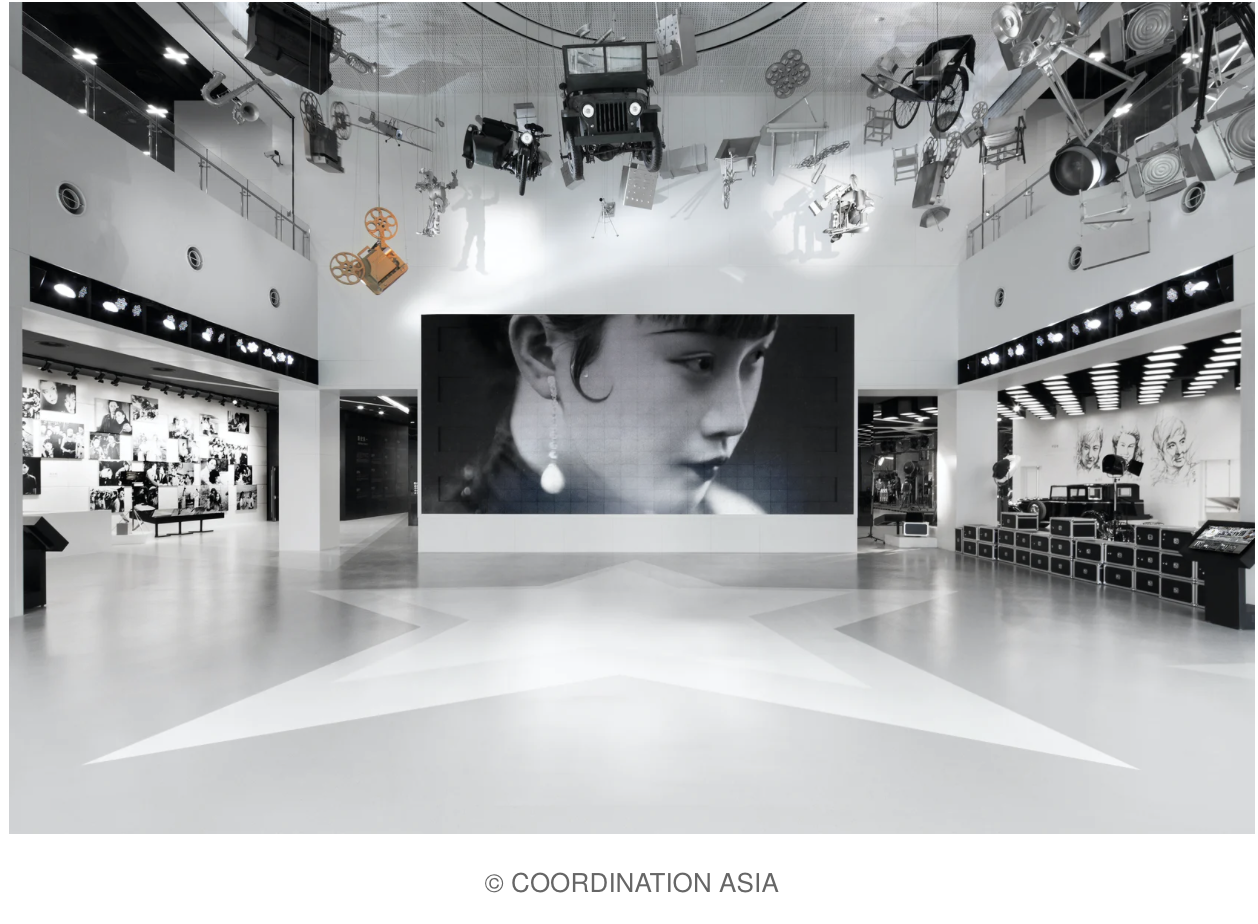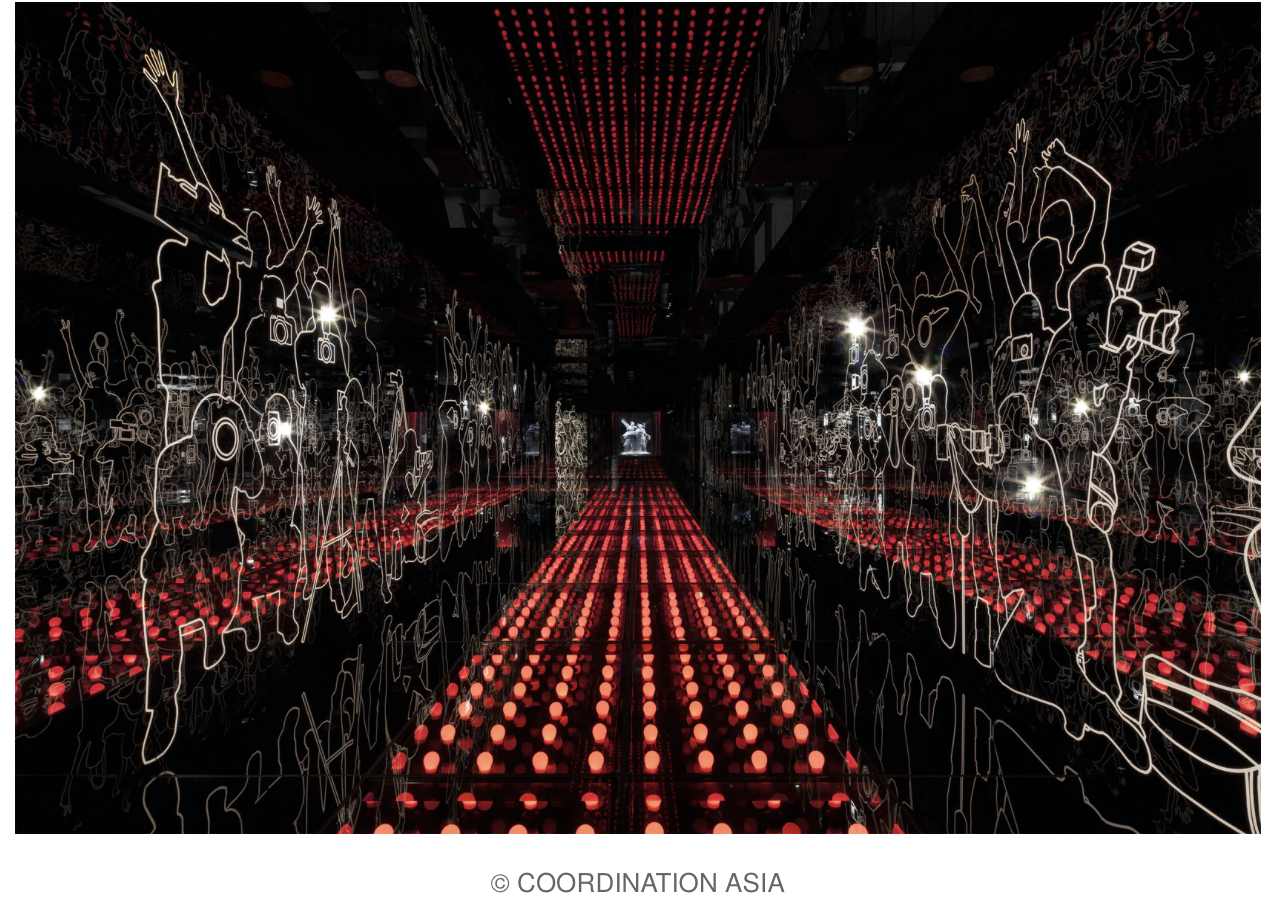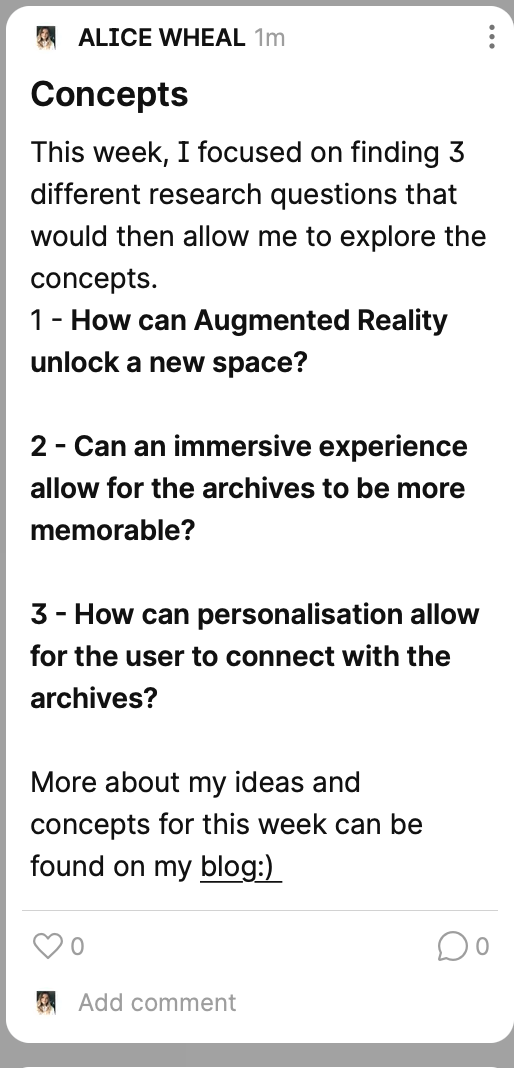Week Eight
Lecture Notes
Lecture Reflection:
Within the lecture for this week, we looked at the methods and approaches that allow us to get ideas. Torten Posselt spoke about making sure that you are always 5 steps ahead when it comes to ideas, basing the decisions on the process that you make at the beginning of the project. Quickly finding or if things work or don’t work. Within Accept and Proceed, they always start every project with a workshop that allows them to look at imagery and test ideas with the client and focusing on the emotional level with the client which allows them to connect. Luke Veerman looked at how you need to take it further than how the client wants to take it. Easy to get it out and get outside. Focussing on how to interact and also create as many ideas as possible that will then allow you to select which are strong enough. I think all the points are valid for this week, I look forward to testing their ways later on in the week.
Resource Notes:
Resource Reflection:
R1
Within the David Carson, there was a lot of jokes about the work that he has done and what he has achieved. The main bit of information that I want to take away from his work is the emotional level of design, he spoke about the need for people to understand the message before they are given the rest of the information and the emotional response is so important. We need to focus more on the moment of impact.
R2
I have always loved the work of Morag Myerscough and have seen this lecture that she has given before but I wanted to watch it again to see if it gave me any ideas for this weeks concept development. I like how she spoke about it is what you do with your own life and how to make it your own. There was also this element about how do you think about the way you are working, looking and seeing and looking how things work and are put together. She has created such interesting spaces that are for the community and for the needs of brightening peoples lives that looking at how she built up to creating that was really interesting to hear about.
R3
The art of looking sideways with Alan Fletcher was another interesting approach to a book. The main thing with the book is looking at the seeing and the pictures that we don’t see with words. A lot of the book is collated as a montage of imagery, with a lot of visual challenges which makes you look at ordinary objects in a new light. I really like this approach as it makes you think about things really differently.
Research:
concept development – how can you develop the visual outcome of your project to be original and innovative? What emergent technologies can elevate your project outcome?
For the research for this week, i wanted to research some of the technologies but also some of the projects that are similar that i thought 18-30 year olds would be interested in.
Technology
https://www.upgrad.com/blog/top-trending-technologies-in-2021/
This article talks about the trending technologies in 2021,
AI and machine learning
Data Science
Full Stack Development
Robotic Process Automation
Edge Computing
Virtual Reality and Augmented Reality
Blockchain
5G
Cyber Security
Within this Forbes article, it talks about the biggest trends in technology that will come in 2022.
Artificial intelligence everywhere, smart devices.
No code interfaces (OpenAI)
Digitalisation, datafication and virtualisation.
Transparency, governance and accountability
Sustainable energy solutions.
Both these articles are great to just outline the technology that I would be able to use for this project but also looking into the next year to see what could potentially be trending then.
Audience Research
https://f-trend.com/blog/marketing-strategy-millennial-consumers18-35-age-group
Within this article, it talks about the millennial which are the consumers between the ages of 18-35. They are the in-between so they still are online but still want to see people in person, the same with shopping some want online some want offline. 72% share content online once a week, 55% engage with social media content, 51% stay connected to friends and family and 35% stay up to date with brands, products and the latest trends.
https://aragonresearch.com/20-30-year-olds-are-not-millennials-introducing-generation-s/
This article had a different approach and approached those whose who are 23-30 as the generation S. This generation have always had food delivery, map directions, videos and music and they’ve always had information at their finger tips. They are also known for being the generation that likes to save money. They expect the following:
information readily available
technology to be pervasive
Digital Assistants, gaming and immersive technologies will be apart of their lives.
Flexibility with life and work
Both these articles helped me to look at what 18-30 year olds want to be doing but also how they live their lives, which will allow me to look at this within the concept this week.
Case Studies / Similar Projects
Within this case study, Google arts and culture have partnered with the National Air and Space museum, the worlds largest museum to celebrate the 50th anniversary of the first moon-landing which has been done through mobile content series. Done through AMP, accelerated mobile pages technology to bring the Smithsonian collection to life.
Met studio has created some physical piece to enhance the sense of identity in the space within the Savoy Place in London. Adding a series of storylines that fit with the layout and current and proposed usage of the building. A lot of the pieces will be interactive and digital.
Within this case study, it looks at the curated ‘ANNEX"‘ that explore the materiality of data and the interwoven human, environmental and cultural impacts of communication technologies. The installation uses heat to explore the material relationship between data infrastructure and architecture. Inviting the audience to experience this multi sensory exhibition.
https://architizer.com/blog/inspiration/collections/digital-art-projection-installations/
This blog post looks at the future of art and digital installation and interactive spaces. It speaks about how these digital installations allow for the viewers to actively participate and touch, physical participation and social interaction and essential to them all. I won’t go into the detail of all of them but there were 2 which caught my eye as really interesting approaches:
Shanghai Film Museum
Set in a former film studio, this museum includes over 70 interactive digitial installations that educate viewers on the local media industry. “Visitors can digitally dub classic films in a sound studio, walk through a lifelike film set, or feel like a star on a virtual red carpet complete with admiring fans and photographers.”
Plain White
This is an interactive installation that looks at Kadinkskys famed painting, composition VIII. Hear colours condition which he associated each shade with a specific musical note. Blurring the line between visitor and digital dimension.
https://www.dezeen.com/2012/09/29/osmosis-interactive-arena-by-arik-levy/
Within this installation, the digital crystal exhibition at the design museum, which uses visitors body movements to mutate computer generated crystals. Generating unexpected results that one cannot create with conventional tools or intellectualised creativity.
https://www.dezeen.com/2019/10/16/steampunk-pavilion-fologram-tallinn-architecture-biennial/
Within this case study, the architecture was created using augmented reality and woodwork. Method that combined technology in a way that still kept the designers close to the craft of the building.
API
https://www.sciencemuseumgroup.org.uk/about-us/collection/using-our-collection-api/
One thing i noticed on the science museum, is that they are always looking to ways that they are able to outsource their data to other organisations and objects. For example, they have looked at the physical means of viewing and interacting with the collection via Alexa and motion sensors. They have also looked at outsourcing like using twitter. They are asking people to design for them so they are able to expand.
My Visit to Science Museum
I wanted to take a visit to the science museum, so i was able to see what they had on offer and the interactive exhibitions that were already available to them. Whilst wondering around, I realised that alot of the collection that wernt interactive and just objects people wern’t paying attention too. Whereas the ones that were showing how something worked or actual interactive in showing something were the most popular and alot of people seemed to crowd around, this led me to thinking how would I be able to incorporate my idea that could physically change how the space is looked at.
Workshop Challenge:
Develop a broad selection of initial design ideas that are appropriate to your positioning (mission) statement and target audience. We encourage you to think laterally and push your ideas above and beyond the project strategy.
Post initial design developments to your blog.
Add your initial concepts onto the Ideas Wall to encourage peer feedback. Reflect on the feedback and summarise the comments on your blog.
Seek advice and feedback from your target audience and key stakeholders, such as industry professionals, research groups or any relevant parties. Post feedback and comments onto the Ideas Wall and elaborate on your blog
After last week, I gained some feedback of the directions that I was taking - Physical and Digital as well as the interactive element of my design. But i felt i didn’t have a focus point or a research question that pushed my project along. So my aim for this week is to write a research question for any of the main ideas that I come up with that will allow me to have a focus for the upcoming weeks.
To start of this week, I have written down all of my research that will then help me to write the next mindmap with the ideas.
To summaries the research that i was focusing on, I wanted something that would attract the audience of 18-30 year olds to return and reuse the archive, being able to focus on things that would interest them. I wanted to focus not only on stem but the enjoyment and curiosity. I wanted to have something that was interactive and digital / physical. When looking at the trends there are technology trends of AR, AI and visualisation which are sustainable vs wanting DIY innovation, a narrative and interactive immersive experiences. The audience are interested in things that are immersive technology that saves them time but stuff that may always be available to then. `
Within the Lecture this week, Luke Veerman said to just write down all the ideas that you have and to keep writing as these are sometimes the best ideas. So within the below mindmap, I have written out some of the initial design ideas that i have using the Alan Fletcher technique of looking at things sideways.
This then allowed me to come up with some ideas:
1- Visually being able to explore the physical archive anywhere.
2 - Having an app or site that would allow you to have a profile of your favourite pieces.
3 - Having a pop up or portable installation that would allow people to experience different pieces and collections within the archives.
4 -Having an interactive wall within the museum and online that would allow you to explore the archives.
5- Interactive town centre pop ups on bus stops.
6- An online museum created with AR
7 - creating something that is purely physical that could be a book or else.
8 - Personal questions that would then allow for personalised collection of the archives.
I have then narrowed down these ideas to 3 general research questions:
1 - How can Augmented Reality unlock new space?
2 - Can an immersive experience allow for the archives to be more memorable?
3 - How can personalisation allow for the user to connect with the archives?
For each of the questions I listed the ideas under each which I was interested in doing. The main reason for these ideas is trying to engage with the audience group of 18-30 year olds, with the previous research from the museum being that a lot of younger people only visit the site for research and don’t visit the site for a lot else. How can we gain that engagement but also allow them to relate and find things that interest them in the many thousand archives that are on the website?
1 - How can Augmented Reality unlock a new space?
Visually being able to explore the physical archive anywhere, an online museum created with AR.
AR Installation space combining the physical and the digital.
2 - Can an immersive experience allow for the archives to be more memorable?
Having an interactive wall within the museum and online that would allow you to explore the archives.
Having a pop up or portable installation that would allow people to experience different pieces and collections within the archives.
3 - How can personalisation allow for the user to connect with the archives?
Personal questions that would then allow for personalised collection of the archives.
Having an app or site that would allow you to have a profile of your favourite pieces.
Once I had decided on these I went on to write a synopsis for each or a process of how they would work:
Visually being able to explore the physical archive anywhere, an online museum created with AR.
Being in a digital era and with the target audience being global, why couldn’t the physical archive space be accessed anywhere in the world? This would be like the new AR art galleries that were created during lockdown to showcase artwork in a new way. This would be an immersive experience that would be able to access via a phone or a computer app. This way the object could be viewed in a 3D form and explained how it is used.
AR Installation space combining the physical and the digital.
Being able to give the archive exposure to people, this would allow a physical space combined with an online platform that would show different objects within different settings - Think pokemon go but archive edition. This space could be small and permanent but also within your local town or city.
Having an interactive wall within the museum and online that would allow you to explore the archives.
Whilst visiting the museum itself, i noticed the ones with the interactive visual aspect were the ones that people were most interested in. If people were able to interact online with the objects then there may be more people visiting the site. There was also this aspect of having an interactive wall in the museum, that people would be able to approach and explore which could then also be translated to the website “Interactive wall today”.
Having a pop up or portable installation that would allow people to experience different pieces and collections within the archives.
Within this concept, I imagine a pop up food or drinks space or even just an space that has been constructed around the purpose of raising awareness of the archives. Potentially if the food was named after the archives or some of the collections and you were given information on the packaging or within the digital screens that surrounded. I feel there could also be a way to explore what if this could be combined with a personal element, if you visit all the pop ups and at the end the app then gives you a summary due to what you ordered what might interest you on the archive.
Personal questions that would then allow for personalised collection of the archives.
Within the museum, there was an interactive space called who am I, which asked you personal questions with a summary at the end - a change of this if personal questions were answered of your interests - could this change the way that people experience the archives? This could be combined with an installation or an the interface online?
Having an app or site that would allow you to have a profile of your favourite pieces.
Following on from the previous on the lines of personalisation, if personalisation was on an archive app that would be a similar layout to instagram where you could explore different collections which you could then favourite and add to your own profile. These would then be transfered to what would show up on your ‘explore line’. You could then share with friends and follow friends on the space.
Sticking with the ideas for this week, I want to mull over them more and then continue to explore them next week.
Weekly Reflection:
I started this week by finding the lecture super helpful in understanding different techniques with coming up with concepts and then listening to Morag and the reason and how we approach different things. I really used Morag’s approach as the main Inspiration for this week. Going on to then research different technology but also really focussing on the installation and interactive approach allow me to see different approaches to case studies from a museum / art perspective. I also found visiting the science museum allowed me to gain first hand knowledge and observe how the public interacted. Then going on to research more about the audience and what they were interested in as well as the upcoming advances in the technology which would allow the design to stay relevant.
Taking all of this into this weeks workshop challenge, this allowed me to then focus on the 3 areas which I thought all of my research led too, which then had 6 different ideas which I look forward to exploring more in weeks to come.
